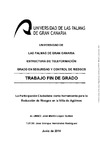Please use this identifier to cite or link to this item:
https://accedacris.ulpgc.es/jspui/handle/10553/68419
| DC Field | Value | Language |
|---|---|---|
| dc.contributor.advisor | Hernández Rodríguez, José Enrique | - |
| dc.contributor.author | López Guillén, José Martín | - |
| dc.date.accessioned | 2020-01-23T03:31:43Z | - |
| dc.date.available | 2018-05-01T00:00:00Z | es |
| dc.date.available | 2020-01-23T03:31:43Z | - |
| dc.date.issued | 2014 | en_US |
| dc.identifier.other | contentdm-postulpgc | es |
| dc.identifier.uri | https://accedacris.ulpgc.es/handle/10553/68419 | - |
| dc.description.abstract | We live in a society in which although we have experimented many advances related to our quality ot lite, technological and industrial progress, etc ... we are exposed to a number ot different risks. This "End ot Grade Work" had as a general objective to analyze citizen's participation as a risk management tool and to detend the possibility ot including it as a tool to encourage the culture ot emergency and selt-protection in Agüimes town. Due to the great experience ot Agüimes in citizen participation I had the collaboration ot The Citizen Participation Department ot Agüimes Council to contact the different neighbourhood associations and carry this work out. First ot ali, seventy-two neighbours were given a questionnaire to know their perception ot risk, their knowledge to tace emergency situations and their ideas about emergency and security services. After a workshop in which, among other things, they were given advices to tace emergency situations, they answer again the same questionnaire to evaluate how the information changed their answers. The results that we could observe were that the neighbours have improved their answers related to emergency situations, their selt protection and emergency and security services level ot knowledge. So, we can conclude, that promoting an emergency and selt protection culture among neighbourhood, would create sater awareness to people. For that reason, strategies to minimize the risks should be implemented, where citizen participation could be a tool to achieve this purpose. | en_US |
| dc.description.abstract | Vivimos en una sociedad que, a pesar de haber sufrido grandes avances relacionados con la calidad de vida, desarrollo tecnológico, industrial, etc .... estamos igualmente expuestos a numerosos riesgos de diferente índole. Este Trabajo Fin de Grado tuvo como objetivo general analizar la Participación Ciudadana como una herramienta de gestión del riesgo y argumentar la posibilidad de incluirla como instrumento para fomentar una cultura de emergencia o de autoprotección en el municipio de Agüimes. Debido a que este municipio cuenta con una dilatada experiencia en Participación Ciudadana, se contó con la colaboración de la Concejalía de Participación Ciudadana para contactar con diversas Asociaciones Vecinales y llevar a cabo este estudio. Inicialmente se les pasó a 72 vecinos un cuestionario para conocer; su percepción sobre el riesgo; sus conocimientos para afrontar situaciones de emergencia; y qué nociones tenían sobre los servicios de emergencia y seguridad. Tras recibir una charla en la cual, entre otras cosas, se les facilitaban consejos ante situaciones de emergencia, volvían a contestar el mismo cuestionario para valorar en qué medida, la información facilitada en la charla, había cambiado sus respuestas. Después de analizar los resultados, se observó cómo los encuestados modificaron sus contestaciones hacia valores que reflejaban una considerable mejoría en cuanto a sus conocimientos a la hora de afrontar una situación de emergencia, sus actitudes de autoprotección y su nivel de conocimientos sobre los servicios de emergencias y seguridad. Se llega a la conclusión que generando una cultura de emergencias y de autoprotección entre los vecinos, se crearán entornos más seguros. Por ese motivo se deberían implementar, en la gestión municipal, estrategias para minimizar los riesgos, donde la Participación Ciudadana pudiera ser una herramienta para lograr tal fin. | en_US |
| dc.format | es | |
| dc.language | spa | en_US |
| dc.rights | Acceso restringido para la comunidad universitaria de la ULPGC | es |
| dc.subject | 631106 Sociología urbana | en_US |
| dc.title | La participación ciudadana como herramienta para la reducción de riesgos en la Villa de Agüimes | en_US |
| dc.type | info:eu-repo/semantics/bachelorThesis | en_US |
| dc.type | BachelorThesis | en_US |
| dc.contributor.facultad | Estructura de Teleformación ULPGC | en_US |
| dc.identifier.absysnet | 741279 | es |
| dc.investigacion | Ciencias Sociales y Jurídicas | en_US |
| dc.type2 | Trabajo final de grado | en_US |
| dc.description.notas | Grado en Seguridad y Control de Riesgos | en_US |
| dc.description.numberofpages | 140 | es |
| dc.utils.revision | Sí | en_US |
| dc.identifier.matricula | TFT-32646 | es |
| dc.identifier.ulpgc | Sí | en_US |
| dc.contributor.buulpgc | BU-TEL | en_US |
| dc.contributor.titulacion | Grado en Seguridad y Control de Riesgos (No Presencial) | es |
| item.grantfulltext | restricted | - |
| item.fulltext | Con texto completo | - |
| crisitem.advisor.dept | Departamento de Enfermería | - |
| Appears in Collections: | Trabajo final de grado Restringido ULPGC | |
Page view(s)
44
checked on Dec 30, 2023
Download(s)
30
checked on Dec 30, 2023
Google ScholarTM
Check
Share
Export metadata
Items in accedaCRIS are protected by copyright, with all rights reserved, unless otherwise indicated.
